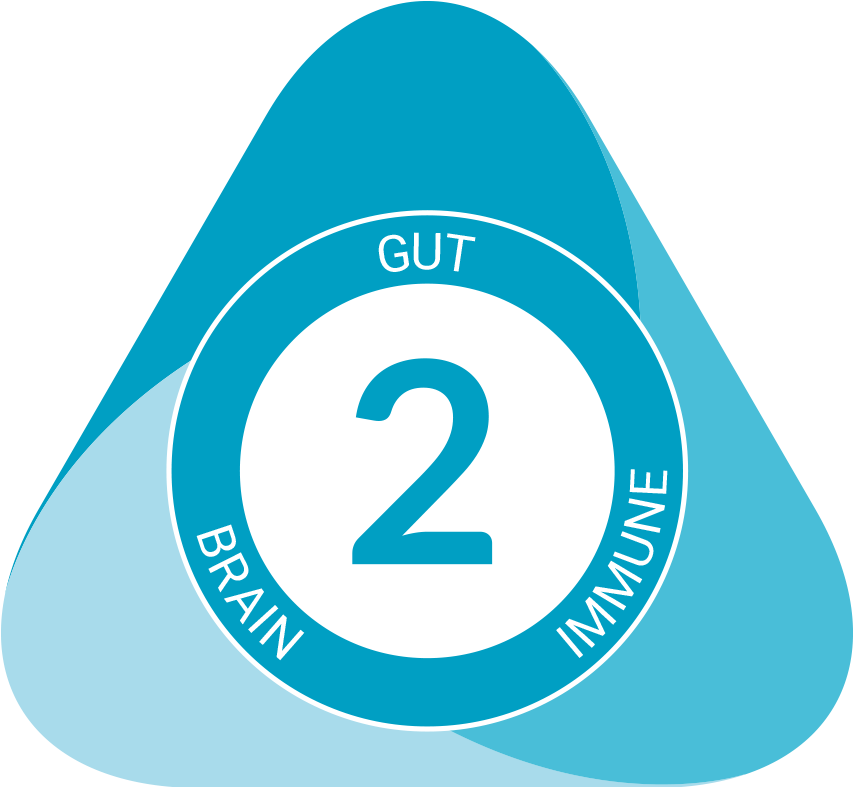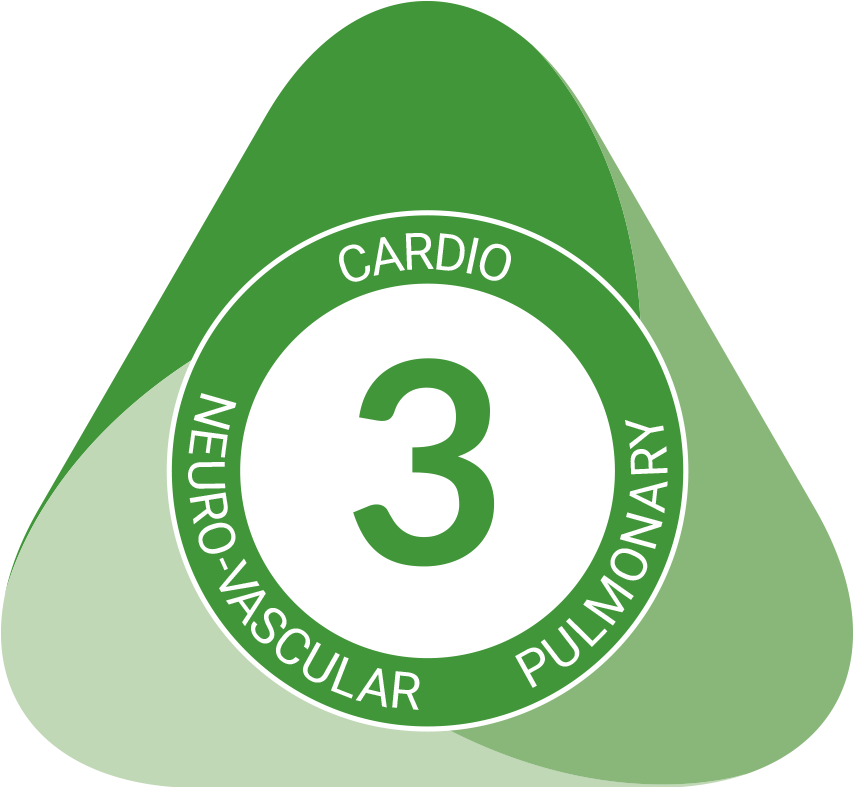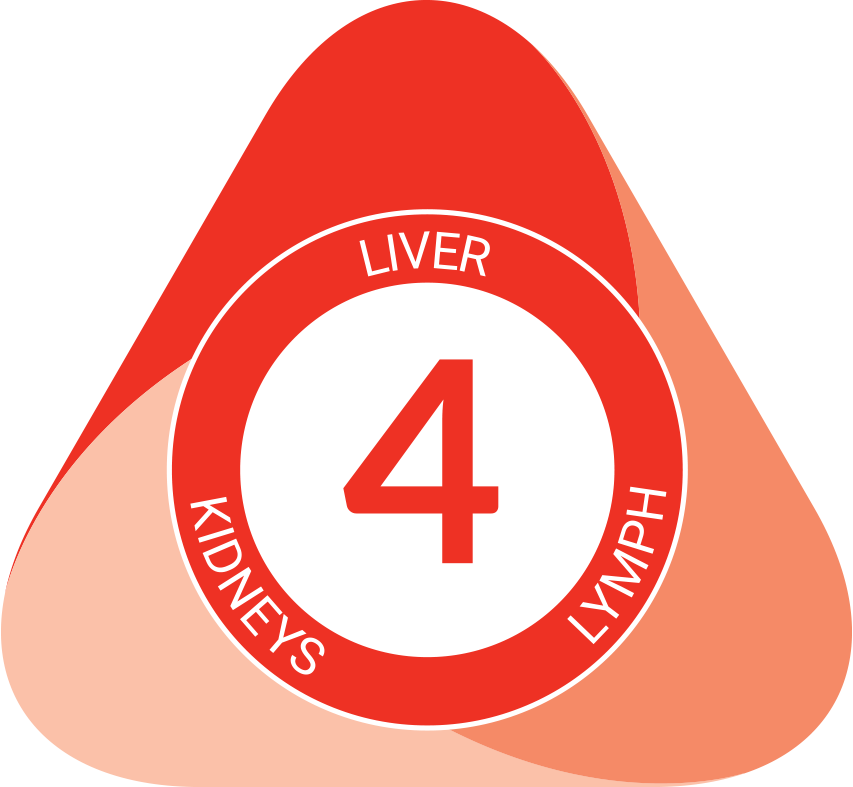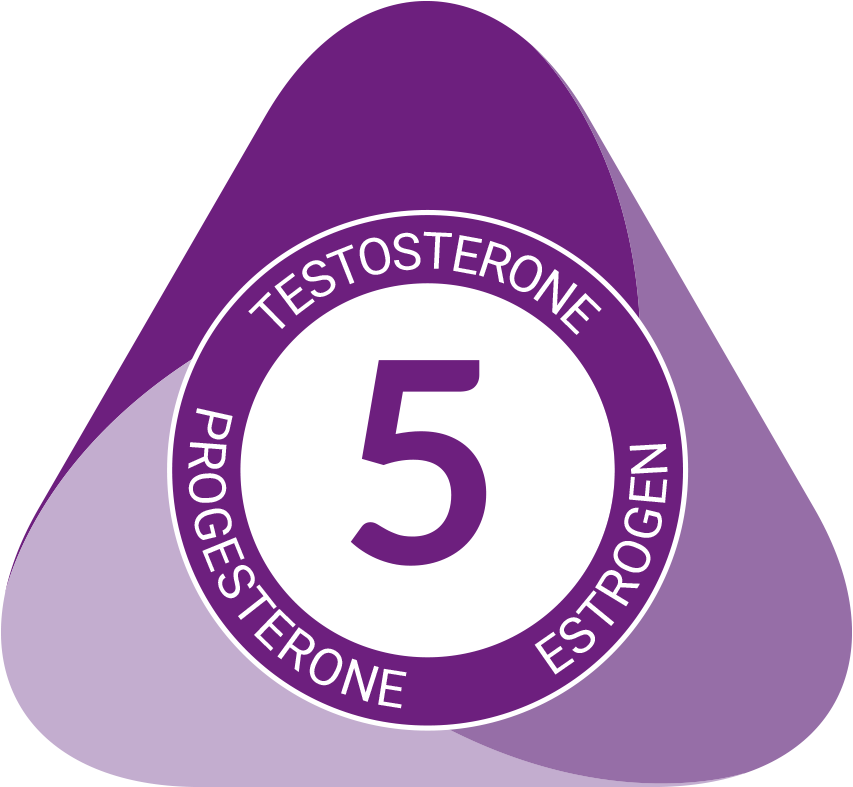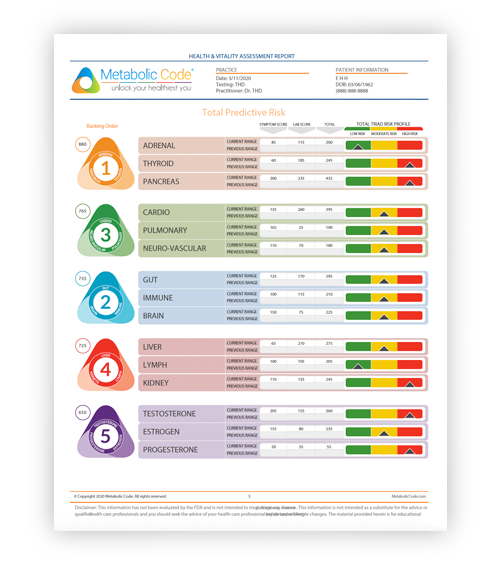TRIAD 1 – Energy OLD
Metabolic Code® TRIAD 1™
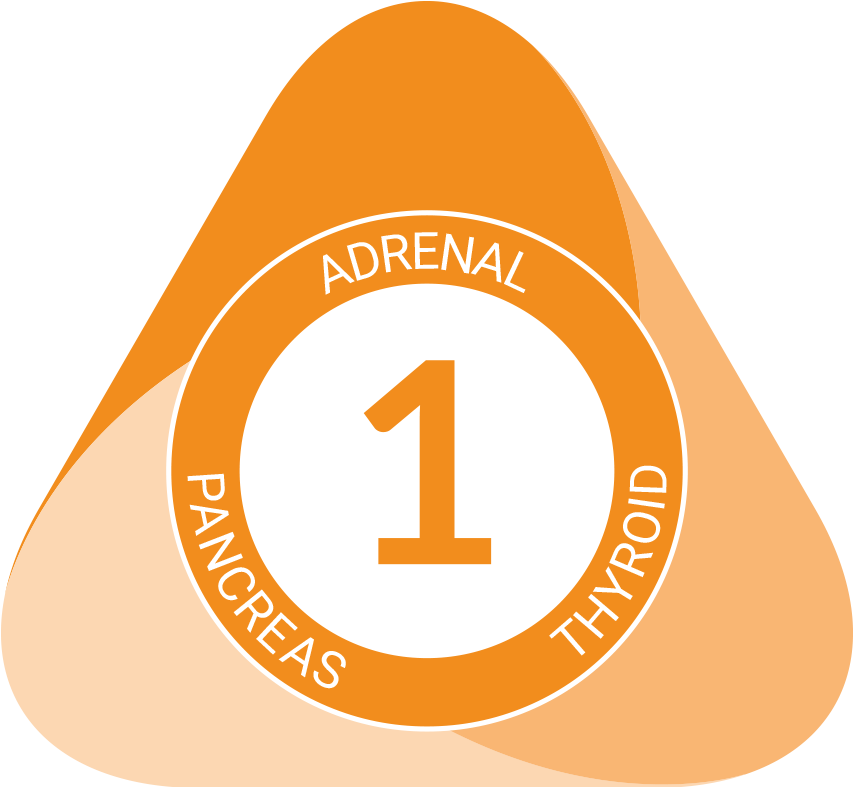
TRIAD 1: Energy
(Adrenal, Thyroid, Pancreas)
TRIAD 1: Energy
(Adrenal, Thyroid, Pancreas)
This TRIAD encompasses the relationship between 3 important hormones: cortisol, insulin, and thyroid. These hormones reflect the current state of stress, sugar, and metabolism. In their most basic function, each is responsible for energy production and circulation.
When TRIAD 1 is unbalanced, a person feels fatigued and has a greater risk of being overweight or obese. When TRIAD 1 is balanced, a person feels vital and healthy.
ADRENAL
 LOCATION
LOCATION
The adrenals are pyramid-shaped glands that sit on top of each kidney. The adrenal glands contain an inner medulla and an outer cortex, the interior or central portions of the adrenal glands house the adrenal medulla, while the exterior or outer portion of the adrenal glands contain the adrenal cortex.
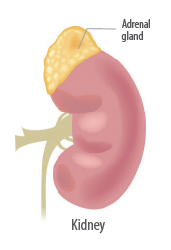
FUNCTION
The adrenal medulla secretes epinephrine (adrenaline) and norepinephrine (noradrenaline), two chemicals found in high levels in the brain called catecholamines. Catecholamines are released in high amounts in response to acute stress and control body functions that are beyond conscious control like pupil dilation, heartbeat, digestion, and secretions of glands. Under chronic stress too much of theses chemicals are produced resulting in hyperarousal of your nervous system.
The adrenal cortex secretes more than thirty different steroids and hormones (known as corticosteroids). The most important corticosteroids are cortisol, aldosterone, and the adrenal androgens (sex hormones, like estrone and the prohormone DHEA). Cortisol is the main hormone secreted in reaction to stress.
RELATIONSHIP
Chronic stress can increase the production of adrenal hormones, especially cortisol, norepinephrine and epinephrine. Chronic stress responses can be triggered by emotional stress, too much exercise, inadequate sleep, nutritional deficiencies, environmental toxins and physical illnesses.
Chronic stress can cause your body to enter into three stages – initial stress hormone production, overactive adrenals, and adrenal exhaustion. High levels of stress hormones have a dramatic impact on your future health, leading to the breakdown of lean muscle tissue, poor blood sugar regulation, reduced immune balance, increased belly fat accumulation and slowing down of your metabolic rate all resulting in increased inflammation response.
Inflammation is thought to be the principle process that accelerates aging and leads to chronic illnesses like heart disease, diabetes, cancer and Alzheimer’s disease. You can get all sorts of variations in stress patterns when under chronic stress. But, as you age and are under more duress, your body slowly but surely changes from a metabolism leading to health to a metabolism leading you to a path of chronic illness.
IF CORTISOL LEVELS ARE HIGH, the following symptoms may occur:
- Anxiousness, nervousness
- Increases cravings for carbohydrates and sugar
- Increases cholesterol and triglycerides
- Mid-day fatigue
- Short-term memory loss
- Sleep disturbances
- Mood disorders
- Alterations in immune system balance, less ability to fight off infections
- Increases in inflammatory cytokines, such as TNF alpha, IL-6 leading to allergies
- Estrogen dominance
- Thyroid hormone levels can be lowered slowing metabolism
- Increased insulin release and blood sugar regulation
- Weight gain
- Aches and pains
- Hair loss
IF CORTISOL LEVELS ARE HIGH, the following symptoms may occur:
- Anxiousness, nervousness
- Increases cravings for carbohydrates and sugar
- Increases cholesterol and triglycerides
- Mid-day fatigue
- Short-term memory loss
- Sleep disturbances
- Mood disorders
- Alterations in immune system balance, less ability to fight off infections
- Increases in inflammatory cytokines, such as TNF alpha, IL-6 leading to allergies
- Estrogen dominance
- Thyroid hormone levels can be lowered slowing metabolism
- Increased insulin release and blood sugar regulation
- Weight gain
- Aches and pains
- Hair loss
THYROID
LOCATION
The thyroid gland is the largest gland in the neck. It is situated in the anterior (front) neck below the skin and muscle layers. The thyroid gland takes the shape of a butterfly with the two wings being represented by the left and right thyroid lobes, which wrap around the trachea.
FUNCTION
The thyroid gland releases thyroid hormones that are the driving force in your metabolic rate. Everything from the utilization of carbohydrates and fat in your food, to promoting protein synthesis needed for cell growth and the production of key biochemical compounds, like neurotransmitters Thyroid hormones activate nearly every receptor to hormones and neurotransmitters in your body. They also are responsible for activating your genetic transcription. Subtle changes in thyroid hormone balance can have a dramatic impact on your metabolic code. Low hormones can turn off your insulin receptors leading to weight gain, reduce absorption of nutrients, and even cause you to become depressed.

RELATIONSHIP
Major triggers that can lead to changes in optimal thyroid hormone production can include:
- Elevated stress
- Environmental exposure, such as pesticides, chemical additives in foods and heavy metals
- Essential Nutrient deficiencies
- Inflammation of the GI tract and loss of beneficial flora
- Exposure to halogens, like fluorine, chlorine and bromine
- Sex hormone imbalances
Thyroid hormone production starts in the hypothalamus located in the brain. Initially, the hypothalamus responds to a metabolic change, such as low body temperature, by releasing thyrotropin releasing factor (TRF), which then signals the pituitary gland to release thyroid stimulating hormone (TSH.) TSH stimulates the thyroid gland to then make thyroid hormone (T4).
The thyroid gland needs the amino acid tyrosine and iodine to make thyroid hormones. The thyroid gland captures these two nutrients from the blood stream and keeps them stored and ready for production, whenever it gets the signal to make the two major hormones, thyroxine (T4) and triiodothyronine (T3). T3 is the more active form of thyroid hormone, while T4 is the most abundant. Factors like low selenium and iron as well as chromium an influence your ability to make thyroid hormone. Chronic stress can lower your ability to make T3 resulting in a drop in metabolic rate as much as 40%. Also your immune system can begin to attack your thyroid leading to the production of antibodies. Within the thyroid gland are also two nodules called the parathyroid gland that secrete calcitonin, which regulates your calcium and phosphate levels in your blood and bones. Any number of shifts can occur in your thyroid hormone numbers. Your measurements included Free T3, Free T4, TSH as well as antibodies TPO and thyroglobulin.
- Slow heart rate
- Insulin resistance
- Weight gain
- Decreased metabolic rate
- Depression
- Cold hands and feet
- Elevated cholesterol
- Hoarseness
- Dry hair, skin, nails
- Constipation
- Reduced rate of breathing
- Aching muscles
- Poor coordination
- Fatigue, insomnia
- Poor concentration
- Infertility
- Menstrual Irregularities
- Low body temperature
- Heartburn
- Slow to start in the morning
- Mental fogginess, Memory loss
- Heart failure
- Palpitations
- Heat intolerance
- Nervousness
- Insomnia
- Breathlessness
- Increased bowel movements
- Light or absent menstrual periods
- Fatigue
- Fast heart rate
- Trembling hands
- Weight loss
- Muscle weakness
- Warm moist skin
- Hair loss
PANCREAS

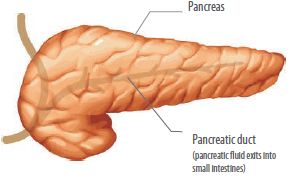
LOCATION
The pancreas is located behind the stomach and is attached to the small intestine.
FUNCTION
The pancreas has two functions. As an excretory gland, it secretes digestive juices into the small intestine by way of the pancreatic duct. As an endocrine gland, the pancreas secretes hormones from a group of specialized cells known as the islets of Langerhans.
The islets of Langerhans contain three types of hormone-secreting cells—the alpha cells, which secrete glucagon (hormone that increase blood sugar levels); the beta cells, which secrete insulin (which lowers blood sugar levels); and the delta cells, which secrete somatostatin (a hormone that inhibits gastric-acid release important in proper digestion). Somatostatin is also secreted in other parts of the body.
Each hormone has an important role in maintaining the balance of blood glucose concentration and supplying cells with energy. Glucose is burned to produce energy for cells in the form of adenosine triphosphate (ATP), the “energy molecule” that runs body functions. Insulin decreases the concentration of glucose in the blood. First, it stimulates the conversion of glucose to be stored as glycogen in the liver and muscle tissue. Insulin facilitates the transport of glucose across the cell membranes of cells. These cells, including skeletal and cardiac muscle, the brain as well as cells in adipose (fat) tissue, have insulin receptors. Glucose uptake by these cells results in a decrease in the blood glucose concentration. Under certain conditions people will begin to release too much insulin because cells begin to become “resistant” to its signal. This is called insulin resistance.
RELATIONSHIP
Many serious, chronic conditions are associated with impaired blood sugar regulation. One of the more serious is type 2 diabetes and its complicating factors. The inability to lower blood sugar in people with type 2 diabetes is linked to several predisposing conditions, including impaired insulin secretion, hyperinsulinemia, insulin resistance, impaired glucose tolerance, and increased glucose production by the liver. All these conditions occur when the pancreas is not working efficiently. The two glands that most influence the metabolic performance of the pancreas are the thyroid gland and the adrenal glands
.
Hyperinsulinemia is an overproduction of insulin by the pancreas. The causes of Hyperinsulinemia include obesity, with age, chronic stress, low thyroid hormone, environmental pollutants, dietary deficiencies and a high-carbohydrate or high-sugar diet, lack of exercise. Frequent spikes in blood sugar require the pancreas to release insulin, resulting in overstimulation of the beta cells and increased insulin secretion. This promotes excessive storage of visceral fat which has drastic effects on your metabolic health.
Insulin resistance (IR) is defined as an inability of insulin to bind to the insulin receptor on a cell and carry glucose from the blood into the cells to be used as fuel.
Consequently, blood sugar remains elevated. To compensate, the pancreas initially releases more and more insulin (hyperinsulinemia). Blood glucose can be maintained within normal limits for years if enough insulin is produced. So part of the problem from IR occurs as a result of the build up insulin and glucose in the bloodstream. The other part of the IR problem
is that it rapidly causes the accumulation of belly fat. Insulin is the most inflammatory chemical that your body makes. It causes devastating damage to the eyes, kidneys, brain, heart, and all the capillaries of your cardiovascular system.
You should know that belly fat is not just hanging around! It is a factory for making hundreds of inflammatory chemicals, hormones, enzymes, and signaling substances that begin to accumulate and accelerate the march toward chronic illnesses. Eventually the pancreas can no longer make enough insulin or the insulin signal cannot be heard efficiently. At this point you become a Type 2 diabetic.
- Chronic inflammation
- Kidney damage
- Cardiovascular damage
- Erectile dysfunction
- Hypertension
- Weight gain and obesity
- Sleep disturbances; sleep apnea
- Neurochemical imbalances
- Hormonal imbalances
- Dementia
- Arterial damage
- Premature aging
- Macular degeneration
How the Metabolic Code can help
1. Labs & Lifestyle Questionnaire
Take our signature comprehensive lab panel and lifestyle questionnaire to identify where your systems are currently out of balance.
2. Personalized Supplement Program
Based on your results take pharmaceutical grade and clinically tested supplements that are compounded specifically for each TRIAD.
3. Metabolic Code Diet
Based on your profile you will get a detailed Metabolic Code Diet program that will significantly benefit your results and help you reach a healthy weight.


